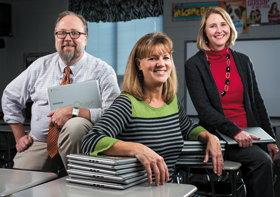Total Package: How New Notebooks Simplify the Classroom Experience
At Blue Springs R-IV School District in Blue Springs, Mo., IT administrators are on a mission to simplify the classroom experience.
Gone is the mélange of interactive whiteboards, document cameras and student response systems that used to crowd the district’s learning landscape. In its place is a fresh crop of hybrid notebook/tablet computers that promise to do everything those old tools could do and more.
“All the functions that teachers need are integrated into the one device,” says Tim Jones, the district’s director of technology. “We can eliminate a lot of extra equipment. It’s a much simpler world in the classroom.”
That simplicity creates fewer distractions and drives efficiencies in the classroom, freeing up educators to focus on individual student needs. In theory, Jones and others say these benefits should translate into a richer student learning experience.
The reality is slightly more complicated, of course. For starters, schools have to identify the right tools and self-contained educational applications capable of effectively replacing aging classroom hardware. Training is essential. Students won’t benefit from the technology unless educators have the confidence to use it effectively in the classroom. As with any large-scale integration, learning how to use new devices takes time.
It’s a process, but it’s worth the wait, says Camillia Matuk, an assistant professor of educational communication and technology at New York University’s Steinhardt School of Culture, Education and Human Development.
“If a mobile device or online app makes good teachers do their work more efficiently, then that technology will also benefit students,” Matuk says.
The percentage of high school students at Blue Springs R-IV School District who are bringing their own notebooks or tablets to school this year, while 95 percent are bringing smartphones
SOURCE: Tim Jones, Director of Technology, Blue Springs R-IV School District
New Way of Thinking
That was at least part of the thinking in Blue Springs in 2014 when administrators simultaneously launched mobile computing and bring-your-own-device initiatives.
The district purchased 1,170 Lenovo ThinkPad Helix convertible ultrabooks for faculty last spring and followed up that investment with the purchase of 3,000 Lenovo ThinkPad Yoga 11e convertible notebooks. The machines were distributed in mobile carts to each school in fall 2014. The convertible notebooks, which transform into tablets by flipping the screens over the keyboards, augment 2,000 tablet devices previously purchased by the district.
In addition to these purchases, administrators recently began allowing high school students to bring their own notebooks, tablets and smartphones to class for use on the district’s network.
Together, the two moves represent an evolution in thinking for the district. About eight years ago, Blue Springs made a significant investment in interactive whiteboards, document cameras and student response systems at its 22 schools. But that technology was beginning to show its age.
Rather than reinvest in similar devices, school officials reallocated a chunk of the district’s budget for new technology to convertible notebooks. The thinking was that, with the right apps, the machines could do everything the old devices could do and more, but in a portable, versatile form factor.
So far, that thinking is paying off. For example, to re-create the functionality of an interactive whiteboard, teachers pair their Lenovo Helix ultrabooks with an Epson Powerlite 955 or 956 LCD wireless projector.
If it’s a tablet they’re after, educators simply undock the Lenovo’s screen from its attached keyboard.
Jones describes a classroom environment where teachers are free to walk from student to student, writing directly on their tablets and projecting that information to a screen in the front of the room. An integrated camera means the Lenovo tablets can perform many of the tasks previously reserved for document cameras, Jones says. Simply attach a tablet stand to beam drawings and 3D images directly to a projector screen.
The installed Windows 8 operating system enables teachers to share online video, associated web content and custom PowerPoint presentations with students at the push of a button.
With the right mobile apps or web-based tools, the tablets also effectively double as student response systems, allowing teachers to poll students to ensure they understand important concepts, Jones says.

Photo: Dan Videtich
Fort Osage School District administrators John Schuler, Debbie Smith (center) and Dr. Maria Fleming are using Chromebooks to transform education.
Carrie Hochgrebe, the district’s technology instructional coach, says the integration of notebooks in class promotes more personalized instruction. A host of new online tools, such as resources for reading and writing, help educators home in on students’ individual weaknesses and provide on-the-spot remediation.
The Case for Chromebooks
Blue Springs isn’t the only district using notebooks and tablets to replace outdated technology.
At the Fort Osage School District in Independence, Mo., educators are creating a more versatile, efficient one-to-one learning environment with the help of Chromebooks.
The 12-school district has purchased 3,600 Samsung Chromebooks over the previous two years.
Eighth- and ninth-graders received machines earlier this year. Seventh-graders received machines last year. Second- to sixth-grade classrooms are being equipped with mobile carts that help teachers manage how and when the technology is used in class.
Next year, the IT department plans to issue devices to all remaining high school students and finish its rollout of mobile carts to the elementary classes, says Debbie Smith, the district’s director of technology.
As the project gets underway, teachers are encouraged to spend time adjusting to the technology and changing how they teach, Smith says.
With Google Classroom, teachers can set up class pages online and create assignments with due dates, says Dr. Maria Fleming, the district’s assistant superintendent of educational services.
Students check the pages for assignments, work on those assignments in the form of online Google Docs, and turn those assignments in online. Teachers can quickly see which students have turned in their work and grade assignments using the Classroom app.
Collaboration is another benefit. At night, if students and faculty are online simultaneously, students can ask questions and teachers can give instant feedback and provide suggestions for immediate, personalized learning, Smith says.
Plus, if children miss school, parents no longer need to call in for homework assignments. Rather, students simply log in and get their assignments online — yet another potential timesaver for schools, says John Schuler, principal of Osage Trail Middle School.
Long on Promise
The promise of a more efficient and versatile classroom has attracted the attention of educators at Boise School District in Boise, Idaho.
The district, which is currently phasing in one-to-one and BYOD initiatives, purchased 2,400 Chromebooks for use in its schools in summer 2014. Educators introduced Google Apps and Google Classroom in fall 2014.
“I’m hearing from early adopters that they are excited about the opportunity to grade and collaborate on student papers and that the management of their own files is much simpler,” says David Roberts, the district’s administrator of technology.
At Blue Springs, some teachers have fully transitioned to mobile devices, while others continue to rely on older technology.
“The teachers are in different points in the transition,” Jones says. “With any big change, teachers have to get to that comfort level at their own speed. But over time, they will realize it is much simpler to just pop the tablet off the keyboard and walk around, launch videos and write notes on the tablet screen.”









